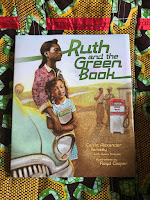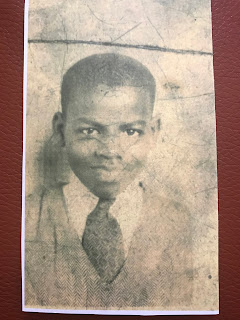The First journey
I was born with wavy, curly hair. As I grew, my hair turned more coarse and kinky. My mother brushed and combed my hair and I wore braids a good part of childhood. It was the practice in our home that every couple of weeks, to keep your hair soft and your scalp healthy Mama would oil our scalp. She would part it into small sections and apply a little Vaseline or
Hair Rep. Mama knew how to french braid our hair and occasionally we would have a different do. Sometimes our Daddy did our hair and it would be braided so tight that it gave our eyes a bit of a surprised look. Daddy's hair dos stayed tidy for several days and only needed a small amount of brushing to put loose hairs back in place.
The Second Journey
For special occasions we got our hair pressed. This was an all day ordeal. We had a family friend that would come over for this. First, you'd get your hair washed nice and clean then it was parted into sections and combed through. After your hair was dry you waited your turn to get 'in the chair'. Our family friend would do my two sister's hair then mine and sometimes my Mother's hair. A hot comb was placed on the stove until it was very hot. Then the comb was cooled just a bit by wiping it on a towel. A small section of your hair would be parted, oil (Hair Rep) added and the the comb was applied. It was an art, if the comb was too hot it would burn your hair and it could fall out. But just the right amount of oil and the right temperature comb worked like magic. The hot comb was dragged from the scalp to the end of the hair. This was repeated until all the hair was straightened. After that the curling iron was heated. Small sections of your hair were parted and the curling iron twisted into your hair creating a large curl. Afterward your hair could be styled any way you wanted. I remember feeling so glamorous and pretty after the long ordeal. We wore foam rollers to bed and tied our hair in silk scarves to protect it. This 'pressing' would last several weeks. Water and any kind of moisture would undo a pressing.
Journey Three-The age of perms
For many African Americans a perm was a way to straighten the hair. (I can remember many conversations with my white friends about why I permed my hair. Their experience was that perming your hair was a way to get waves and curls, the exact opposite of the reason African Americans permed their hair) Chemicals were placed on your hair, combed through and then rinsed out. The process took an hour or so but the results were like pressing your hair and it didn't take all day. Perms lasted longer but moisture was still not our friend. Moisture would take the curl out of your do. After a perm you could roll and set your hair overnight and style your hair in the morning. This required sleeping on rollers overnight for years and avoiding getting your hair wet or damp.
Journey Four- The Natural/Afro
As styles changed and our country changed African American hair reflected the times. We went from being Negroes to being Black and Proud, both of who we were and what we looked like. We embraced our skin color and our kinky hair. Proud Blacks sported the Afro or Natural. For me this was an exciting time. At last we could wear our hair the way it grew out of our heads, no chemicals, low maintenance and all you needed was an afro-pick. (Truthfully we still fussed over our hair to make sure it was shaped right and attractive and for many women the more like
Angela Davis the better). A Natural for me meant freedom, we were redefining what beautiful meant.

After the 70's we had a choice of what we wanted our hair to look like. Perms were back, some people continued to wear a Natural but s shorter, closer version. I experimented with a couple of New Wave styles before getting a Hairdresser that cut my hair in such a way that it reflected my life style. I tried some crazy colors and at last went back to the new and improved perm. This meant going back to rollers and now a hot curling iron. My hair took 30-45 minutes in the morning before work. I liked how it looked so I made the sacrifice.
The last leg of my journey was one that I struggled with the longest. I remember seeing
Whoopi Goldberg for the first time and wondering what she had done to her hair. I didn't dislike it, and I became curious about it. I grew to love it and wanted to take the plunge myself. It took me years before I decided to do it, then in 1999 I decided to lock my hair. I went to my hairdresser for the last time and told her to cut my hair. She cut my hair to 1 inch all over. When my hair grew to 2 inches the process began. At 2 inches I found a Salon that specialized in dreadlocks or locked hair. The hair stylist washed my hair and twisted sections of my hair. Every 2 weeks I came back to have this repeated. After several months the twisted hair started to adhere to itself or "lock." I continued trips to the Salon for about 4 months. After my hair locked, I could take care of it myself and no longer went to the Salon. (in fact I haven't been back since) Locked hair can be washed and styled and colored and cut and it stays locked. To date this has been my favorite hair style. It's natural, I can get it wet, it's a statement, I can sleep on it, and I just wash it and go! I will admit it does take a while to dry naturally but in the Summer it's great! It's also been a great teaching tool. When I was teaching young children were curious about it and so I simply explained how my hair came to be like it is, I often invited them to touch it and they were surprised at how it felt. On the other hand not so young adults were equally as curious and just simply touched without asking. I have corrected some and asked others please not to and given them the same explanation as the children. It's a great lesson in respecting personal space. Other adult friends are curious and I sometimes invite them to touch it. It's an odd thing, this is the only hairstyle I've had that elicited that response.




These old School Ids show a little bit of the dreadlock journey.
I've already begun thinking about what the next hair journey might look like. Just wait and see, it's bound to have a story.


















































